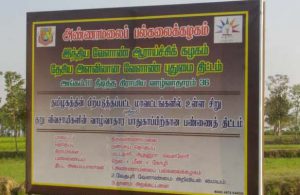National Agriculture Innovation Project
The NAIP-SRLS subproject “Farming Systems for Livelihood Security of Small and Marginal Farmers in Disadvantaged Districts of Tamil Nadu” was jointly implemented by Annamalai University and TNBRD as consortium partners. It covered four disadvantaged districts of Tamil Nadu viz. Cuddalore, Nagapattinam, Villupuram and Tiruvannamalai. The baseline survey of the project indicated that the gross household annual income in Wetland clusters, upland clusters and coastal clusters are Rs.31,822.11, Rs.30,398 and Rs.20,526. The target area was categorized in to three different clusters based on their agro-ecology, as wetland clusters (with mono cropping of rice, transplanted under traditional mode of cropping pattern viz., rice-blackgram), upland clusters (with dryland irrigated crops such as millets, groundnut, vegetables as the base crop) and shore farming clusters (that holds shrimp farming in sea backwaters as the livelihood of fisher folk). Each cluster comprised three villages, where in 100 small and marginal farmers and 100 landless labourers were selected as development partners.


The technical interventions were based on varied integrated farming systems approach to suit the differing agro-ecology and were super imposed with training on other agronomic strategies of component technologies such as INM, IPM, mechanization, post harvest processing etc. For the wetland clusters, an innovative design of integrating fish culture and poultry rearing in the rice fields was implemented in the rice fields of 838 farmers. Infrastructure like poultry cages, concrete posts were created on these farms. For upland clusters, the IFS design included integrating goat and crops of choice of the development partners. Accordingly, 1000 goats @ 2 goats for each of the 500 farming households were given to development partners. For the shore farming clusters, culturing sea weed Gracilaria edulis was disseminated for replacing shrimp culture.
The technical interventions were based on varied integrated farming systems approach to suit the differing agro-ecology and were super imposed with training on other agronomic strategies of component technologies such as INM, IPM, mechanization, post harvest processing etc. For the wetland clusters, an innovative design of integrating fish culture and poultry rearing in the rice fields was implemented in the rice fields of 838 farmers. Infrastructure like poultry cages, concrete posts were created on these farms. For upland clusters, the IFS design included integrating goat and crops of choice of the development partners. Accordingly, 1000 goats @ 2 goats for each of the 500 farming households were given to development partners. For the shore farming clusters, culturing sea weed Gracilaria edulis was disseminated for replacing shrimp culture.

